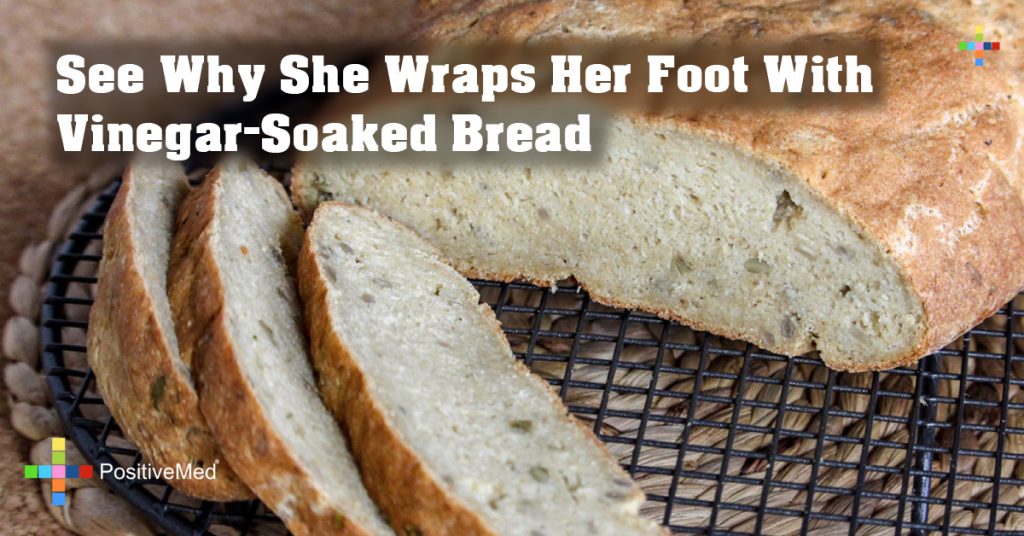
See Why She Wraps Her Foot With Vinegar-Soaked Bread
[nextpage title=”…”]
Calluses develop on areas of the hands and feet where repetitive pressure or friction is applied on a regular basis. This causes the skin to die and thicken in order to prevent further damage to the area. According to the Mayo Clinic, corns and calluses might be caused by any activity that uses something foreign to your body. Using tools, wearing shoes with no socks, and anything else that may cause irritating rubbing on the skin may lead to a callus.

Fortunately, you don’t have to worry about keeping unsightly calluses under wraps, because there are numerous natural remedies that can alleviate the pain and dried skin of a callus. Each of these home remedies requires nothing beyond simple household items, and they are just as effective, if not more so, than medical treatments. Below is an outline of some of the most common effective callus remedies.
1. Bread and Vinegar
This might sound like a strange combination for a home remedy, but it may be the most effective on the list. In order to treat a callus with a mixture of bread and vinegar. Simply soak the bread in white or apple cider vinegar until it is completely saturated. Soaked bread will make a callus soft and easy to erase. The callus should be prepped with a soaking of warm water and a pumice stone to remove dead surface skin.

Take the bread and vinegar blend and massage it into the callus, then cover the paste with a bandage. Leave it on over night, and remove the bandage in the morning. The callus should be drastically reduced, and a light layer of lotion can help restore the skin. If the callus is particularly large, a second treatment might be necessary.
2. Lemon
Lemon juice contains acidic substances that do wonders for reducing the presence of calluses. Lemon juice can be applied to a callus in a number of ways, including directly with a lemon rind or by soaking a cotton ball in the juice. In either case, the deliver method should be pressed into the callus and covered with a bandage so it can soak overnight. The acid will soften the skin of the callus, and it should be entirely gone within a few days.
RELATED ARTICLE: How To Prevent Calluses When Working Out
[/nextpage] [nextpage title=”…”]
3. Castor Oil
Most oils are at least partially good for skin, and the dry skin of a callus is no different. Castor oil has been around for ages and has been used to treat just about everything, but calluses respond particularly well to the oil. A light layer over the surface of the callus covered by a bandage can do wonders, but it may take several weeks to completely remove larger calluses since this is a milder remedy.
4. Epsom Salt
Epsom salt is a great way to help remove calluses. The salt should be mixed with warm water, and the callus should be soaked for at least 10 minutes. The salt and the water will help loosen the dried skin that makes the callus, which in turn makes it much easier to scrape away. Once the callus has soaked sufficiently, you should scour the surface with a pumice stone or a wash cloth. This method may take several days to completely remove a callus, but it is also one of the least intrusive methods.
5. Onion
Onions are a natural remedy for many ailments, and calluses respond quite well to the naturally abrasive nature of the substances found in onions. Soaking an onion slice in vinegar for a few hours will unlock a greater potential for the onion. Once the onion is adequately prepped, it should be pressed into the callus and covered with a bandage. The combination of the vinegar and the onion should make the callus removable by morning.
6. Aspirin
Many people might not realize that aspirin is actually a natural substance. It was first obtained from meadowsweet and willow bark, and it has amazing natural healing properties. Aspirin is transformed into salicylic acid by the body, which is vital to human health. In order to treat a callus with aspirin, it doesn’t have to be taken orally. You can crush an aspirin tablet into powder and create a paste with it using water and a touch of lemon juice. The lemon juice helps activate the salicylic acid in the aspirin, which in turn loosens the dry skin of the callus.
Even though calluses are an ugly part of life, they don’t have to be ignored and covered. Any of these simple remedies can be used to alleviate the symptoms of a callus, and once the callus is gone, proper skin care will stop it from returning.
[/nextpage]






